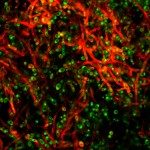Lien vers Pubmed [PMID] – 22080130
Clin. Infect. Dis. 2011 Dec;53(12):e159-69
BACKGROUND: Invasive fungal infection (IFI) represents a life-threatening condition for patients with chronic granulomatous disease (CGD) and causes one-third of deaths in this population. This study offers a descriptive review of invasive mold infection (mIFI) in children with CGD over an extended period of time.
METHODS: In a cohort of patients with CGD registered in the French National database for Primary Immunodeficiency, we performed a retrospective review of proven mIFI episodes (European Organization for Research and Treatment of Cancer/Invasive Fungal Infections Cooperative Group and the National Institute of Allergy and Infectious Diseases Mycoses Study Group 2008 criteria) occurring from 1984 through 2009.
RESULTS: Twenty-nine proven mIFIs were identified in 24 patients. Thirteen (54%) of 24 children were receiving itraconazole prophylaxis. Seven episodes were caused by Aspergillus fumigatus, 10 by Aspergillus nidulans, 2 by Aspergillus species, and 6 by other opportunistic molds (4 patients only had positive pathological examination findings). First proven mIFI occurred later in the group that received itraconazole than in the group without (median time to mIFI, 10 vs 4 years; P < .01), with a higher proportion of infections due to A. nidulans and other opportunistic molds (P < .05). Course of IFI was complex, with the median duration of therapy and hospitalization reaching 446 and 153 days, respectively. Combined antifungal therapy was commonly used. Four patients received geno-identical hematopoietic stem cell transplantation as salvage therapy. Global cure rate among the cohort reached 75%, but sequelae were frequent. Prognosis has improved over time (43% mortality during 1985-1990 vs 6% thereafter; P = .06). Mortality tended to be lower in the group that recieved itraconazole prophylaxis but at the cost of a longer duration of therapy among cured patients.
CONCLUSIONS: Management of mIFI remains challenging in patients with CGD, but significant improvements have been made over the past decade.

